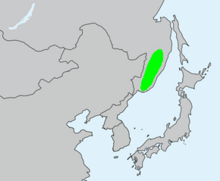Microbiota (plant)
| Microbiota decussata | |
|---|---|
 |
|
| Scientific classification | |
| Kingdom: | Plantae |
| Division: | Pinophyta |
| Class: | Pinopsida |
| Order: | Pinales |
| Family: | Cupressaceae |
| Genus: | Microbiota |
| Species: | M. decussata |
| Binomial name | |
|
Microbiota decussata Kom. |
|
 |
|
| Microbiota decussata range | |
Microbiota is a monotypic genus of evergreen coniferous shrub in the cypress family Cupressaceae, containing only one species, Microbiota decussata (Siberian carpet cypress, Russian arbor-vitae). The plant is native and endemic to a limited area of the Sikhote-Alin mountains in Primorskiy Krai in the Russian Far East. The name causes much confusion because of other meanings for the word "microbiota," but the genus name was derived from "micro," meaning "small" + "Biota," name for a closely related conifer, a species formerly called Biota orientalis, now renamed Platycladus orientalis.
The monotypic taxon Microbiota was discovered in 1923, but political secrecy in the former Soviet Union prevented any knowledge of its existence outside the country for around 50 years.
It is generally accepted as being a distinct genus. It has also been suggested, but not widely followed, that Microbiota could be included in the closely related genus Platycladus. Other fairly close relatives are the genera Juniperus and Cupressus.
Microbiota decussata is a prostrate shrub to 20–50 centimetres (0.66–1.64 ft) in height, and 2–5 metres (6.6–16.4 ft) in spreading width. The foliage forms in flat sprays with scale-like leaves 2–4 mm long. The cones are among the smallest of any conifer, 2–3 mm long, green ripening brown in about 8 months from pollination, and have 4 scales arranged in two opposite pairs. The seeds are 2 mm long, with no wing; there is usually only one seed in each cone, rarely two.
...
Wikipedia

